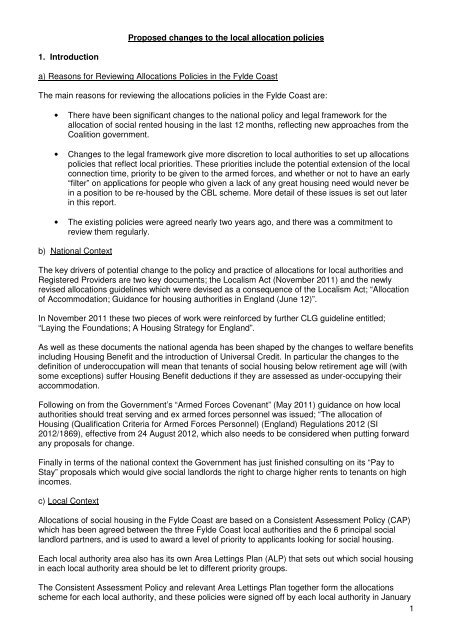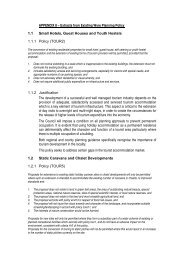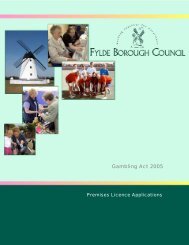Proposed changes to the allocation process - Blackpool Council
Proposed changes to the allocation process - Blackpool Council
Proposed changes to the allocation process - Blackpool Council
Create successful ePaper yourself
Turn your PDF publications into a flip-book with our unique Google optimized e-Paper software.
2011. The My Home Choice Fylde Coast choice based lettings system went live with its first biddinground from 6 th June 2012, so while <strong>the</strong> existing policies are nearly two years old, <strong>the</strong>y have only beenin use for five months <strong>to</strong> date.When <strong>the</strong> CAP and ALPs were approved, <strong>the</strong>re was a commitment <strong>to</strong> regularly review <strong>the</strong> policies <strong>to</strong>ensure that <strong>the</strong>y continue <strong>to</strong> be appropriate.Within <strong>the</strong>ir Area Lettings Plans each authority stressed certain issues that <strong>the</strong>y felt were specific <strong>to</strong><strong>the</strong>m in framing <strong>the</strong>ir ALP and where <strong>the</strong>y had a strategic imperative.<strong>Blackpool</strong>’s key issues were:(i)(ii)(iii)Local ConnectionTransienceThe number of people on <strong>the</strong> housing waiting list for <strong>Blackpool</strong> with no chance of everbeing housed in social housingFylde emphasised:(i) Management of expectations of <strong>the</strong> shortage of available social housing(ii) Rural communities(iii) Large and growing proportion of older people in its area(iv) Opportunities for people <strong>to</strong> access supported housing(v) Low demand for sheltered housing(vi) Access <strong>to</strong> social housing for <strong>the</strong> under 25’s(vii) Accommodation for single peopleWyre’s issues were:(i)(ii)(iii)(iv)Shortage of social rented accommodationRural communitiesLarge and growing proportion of older people and <strong>the</strong> specialist accommodation neededThe need <strong>to</strong> tackle <strong>the</strong> issues of worklessness and regeneration in Fleetwood2. Key legislative <strong>changes</strong>The Localism Act 2011As <strong>the</strong> title of <strong>the</strong> act infers <strong>the</strong> intention of it is <strong>to</strong> give power back <strong>to</strong> local authorities andcommunities. It is a wide ranging piece of legislation, but <strong>the</strong> key housing issues that will affect <strong>the</strong>review of <strong>the</strong> CAP and ALPs are summarised below.(i) HomelessnessThis is one of <strong>the</strong> key <strong>changes</strong> and allows local authorities <strong>to</strong> meet <strong>the</strong>ir homeless duty by offeringsuitable accommodation in <strong>the</strong> private sec<strong>to</strong>r (a consultation period on what “suitable”accommodation should be has just expired), provided that <strong>the</strong> tenancy is for a fixed term of at least12 months and that if <strong>the</strong> applicant becomes unintentionally homeless and reapplies foraccommodation within two years, <strong>the</strong> local authority still has a duty <strong>to</strong> <strong>the</strong>m irrespective of whe<strong>the</strong>r<strong>the</strong> applicant still has a priority need.If we tie in <strong>to</strong> this a strategic aim <strong>to</strong> make better use of <strong>the</strong> private rented sec<strong>to</strong>r <strong>the</strong>n this will help <strong>to</strong>reduce <strong>the</strong> number of people in need of housing and help <strong>to</strong> free up social homes.(ii) Allocations/Qualifying PersonsHere <strong>the</strong> Act amends <strong>the</strong> definitions of “eligible and qualifying persons” and in particular enables alocal authority <strong>to</strong> decide what classes of persons are or are not ‘qualifying persons’ for <strong>the</strong> purpose of2
<strong>allocation</strong>s. The Localism Act has given local authorities <strong>the</strong> opportunity <strong>to</strong> define qualifying personsas those with a local connection and crucially <strong>to</strong> define <strong>the</strong> period of entitlement <strong>to</strong> when a localconnection is achieved beyond that of <strong>the</strong> previous legal definition in section 199 of <strong>the</strong> 1996 HousingAct.In doing this however councils must ensure that classes of people excluded are not done so onunreasonable grounds and that policies must be proportional <strong>to</strong> <strong>the</strong>ir stated goals in <strong>the</strong>ir <strong>allocation</strong>sand tenancy strategies.Ano<strong>the</strong>r big change is that <strong>the</strong> Act gives local authorities and Registered Providers (RPs) <strong>the</strong>opportunity <strong>to</strong> exclude non-priority transfer applicants from <strong>the</strong>ir <strong>allocation</strong> schemes. An offer ofaccommodation <strong>to</strong> an existing tenant seeking a transfer will not be classified as an <strong>allocation</strong>meaning that if <strong>the</strong>y so wish authorities can separate and deal separately with transfer applicants.(iii) Flexible tenanciesAs mentioned above <strong>the</strong> Act also introduces <strong>the</strong> ability <strong>to</strong> offer flexible tenancies. These areessentially <strong>the</strong> same as a secure tenancy but for a fixed term of which <strong>the</strong> minimum period is 2 years,but it is anticipated that those using <strong>the</strong>m will adopt a period of at least 5 years.This is intended <strong>to</strong> remove <strong>the</strong> concept of a tenancy for life and <strong>to</strong> target tenants who may now be inwell paid jobs and who no longer have <strong>the</strong> need for this subsidised form of housing. This option linksin<strong>to</strong> <strong>the</strong> “Pay <strong>to</strong> Stay” proposals which give authorities <strong>the</strong> power <strong>to</strong> let such highly paid tenants <strong>to</strong>stay in properties as long as <strong>the</strong>y are willing <strong>to</strong> pay market rent for <strong>the</strong> privilege.In summary <strong>the</strong>n <strong>the</strong> Act gives local authorities greater freedom <strong>to</strong> set <strong>the</strong>ir own policies about whoshould qualify <strong>to</strong> go on <strong>the</strong> housing waiting list in <strong>the</strong>ir area whilst still having <strong>to</strong> keep <strong>the</strong> “reasonablepreference” and “additional preference” categories <strong>to</strong> safeguard <strong>the</strong> most vulnerable local people.Additional Guidance – Allocation of accommodation: Guidance for local housing authorities inEngland (effective from 29 June 2012)As mentioned above <strong>the</strong> Government has issued new statu<strong>to</strong>ry guidance in conjunction with <strong>the</strong>Localism Act in June 2012. Authorities are obliged <strong>to</strong> have regard <strong>to</strong> this guidance when devising,implementing and modifying <strong>the</strong>ir schemes.The guidance stresses <strong>the</strong> need for local authorities <strong>to</strong> have regard <strong>to</strong> <strong>the</strong>ir homeless and tenancystrategies when preparing or modifying <strong>the</strong>ir schemes.The following are key elements of <strong>the</strong> guidance;• Unacceptable behaviourPreviously in order <strong>to</strong> treat someone as ineligible for housing because of previous unacceptablebehaviour or <strong>to</strong> reduce <strong>the</strong> priority of <strong>the</strong>se applicants, local authorities had <strong>to</strong> define <strong>the</strong> type ofbehaviour as specified in legislation and <strong>to</strong> abide by a specified test.The Localism Act removed <strong>the</strong>se provisions and now leaves it <strong>to</strong> local authorities and RPs <strong>to</strong> definefor <strong>the</strong>mselves what unacceptable behaviour is.• Local connectionUnder <strong>the</strong> previous rules authorities were unable <strong>to</strong> refuse <strong>to</strong> consider applications for housing frompeople without a local connection, but in determining relative priorities for an <strong>allocation</strong>, authoritieswere able <strong>to</strong> have regard <strong>to</strong> whe<strong>the</strong>r or not applicants had a local connection with <strong>the</strong> district.The Localism Act has given authorities <strong>the</strong> power <strong>to</strong> define qualifying persons as those with a localconnection and in turn that period of local connection is not prescribed as previously.3
• Local Connection and armed forces personnelHere <strong>the</strong> guidance initially given was expanded on by <strong>the</strong> specific guidance which came in<strong>to</strong> effect on24 August 2012 and more details of this are set out below.• Working/community contributionAlthough many think that it was <strong>the</strong> Localism Act that gave local authorities <strong>the</strong> discretion <strong>to</strong> givepriority <strong>to</strong> people in work, or who are making a “community contribution”, councils already had <strong>the</strong>sepowers given <strong>to</strong> <strong>the</strong>m by <strong>the</strong> former government in 2009.The Localism Act merely expanded on that and says:“Local authorities are urged <strong>to</strong> consider how <strong>the</strong>y can use <strong>the</strong>ir <strong>allocation</strong> policies <strong>to</strong> supportthose households who want <strong>to</strong> work, as well as those who – while unable <strong>to</strong> engage in paidemployment – are contributing <strong>to</strong> <strong>the</strong>ir community in o<strong>the</strong>r ways, for example, through voluntarywork…..this might involve for example, framing an <strong>allocation</strong> scheme <strong>to</strong> give some preference <strong>to</strong>households who are in low paid work or employment related training, even where <strong>the</strong>y are not in <strong>the</strong>reasonable preference categories, or <strong>to</strong> give greater preference <strong>to</strong> those households in <strong>the</strong>reasonable preference categories who are also in work or who can demonstrate that <strong>the</strong>y are activelyseeking work.”Finally on this subject authorities are urged <strong>to</strong> consider how best <strong>the</strong>y can make use of <strong>the</strong> newpower <strong>to</strong> offer flexible tenancies <strong>to</strong> support households in low paid work and incentivise o<strong>the</strong>rs <strong>to</strong> takeup employment opportunities.• Foster carers and adoptersOn <strong>the</strong> subject of foster carers and adopters <strong>the</strong> guidance says that <strong>the</strong>y may be given “reasonablepreference” for a housing <strong>allocation</strong> on welfare grounds. For clarity this group is defined as:“Foster carers or adopters who would require an extra bedroom <strong>to</strong> accommodate a foster or adoptivechild, authorities will wish <strong>to</strong> weigh up <strong>the</strong> risk that <strong>the</strong> application <strong>to</strong> foster or adopt may beunsuccessful…against <strong>the</strong> wider benefits which would be realised if <strong>the</strong> placement was successful.”• Under occupiersThe statu<strong>to</strong>ry guidance also makes specific reference <strong>to</strong> authorities framing <strong>the</strong>ir <strong>allocation</strong> schemeson this subject in relation <strong>to</strong> <strong>the</strong> Housing Benefit <strong>changes</strong> occurring in April 2013 and gives councils<strong>the</strong> opportunity <strong>to</strong> frame <strong>the</strong>ir proposals as <strong>the</strong>y wish as long as <strong>the</strong>y aren’t breaching statu<strong>to</strong>ryovercrowding legislation specifically <strong>to</strong> fac<strong>to</strong>r in <strong>the</strong> effects of <strong>the</strong> Welfare reform Act 2012. It goes on<strong>to</strong> say that:“Social tenants affected by <strong>the</strong> under occupation measure may choose <strong>to</strong> move <strong>to</strong> more suitablysized accommodation in <strong>the</strong> private rented sec<strong>to</strong>r…one way <strong>to</strong> encourage tenants <strong>to</strong> consider thisoption might be <strong>to</strong> ensure <strong>the</strong>y are given some degree of preference for an <strong>allocation</strong> if <strong>the</strong>y apply fora new social tenancy at a later date.”The practicalities of carrying out such a suggestion would possibly be hard <strong>to</strong> do.The Allocation of Housing (Qualification Criteria for Armed Forces Personnel) (England) Regulations2012 (SI 2012/1869) (effective from 24 August 2012)This guidance supplemented that in <strong>the</strong> general guidance above and is a consequence of <strong>the</strong> “ArmedForces Covenant” that was published by <strong>the</strong> Government on 16 May 2011. That document described:“…an expression that of <strong>the</strong> moral obligation that <strong>the</strong> Government and <strong>the</strong> nation owe <strong>to</strong> those whoserve or have served in <strong>the</strong> armed forces and <strong>the</strong>ir families.”4
These regulations streng<strong>the</strong>n <strong>the</strong> position of some armed forces personnel in seeking access <strong>to</strong>social housing. Specifically <strong>the</strong> guidance says that local authorities should give additional preference<strong>to</strong> <strong>the</strong> following categories of people who fall within one or more of <strong>the</strong> reasonable preferencecategories and who have urgent housing needs:a) former members of <strong>the</strong> armed servicesb) serving members of <strong>the</strong> armed forces who need <strong>to</strong> move because of a serious injury, medicalcondition or disability sustained as a result of <strong>the</strong>ir servicec) bereaved spouses and civil partners of members of <strong>the</strong> armed forces leaving services familyaccommodation following <strong>the</strong> death of <strong>the</strong>ir spouse or partnerd) serving or former members of <strong>the</strong> reserve forces who need <strong>to</strong> move because of a seriousinjury, medical condition or disability sustained as a result of <strong>the</strong>ir serviceThe guidance fur<strong>the</strong>r goes on <strong>to</strong> say that even where <strong>the</strong>re is no local connection <strong>to</strong> an area, localauthorities must not disqualify certain current or former members of <strong>the</strong> armed forces from applyingfor social housing if <strong>the</strong>y are:a) members of <strong>the</strong> armed forces and former service personnel where <strong>the</strong> application is madewithin five years of dischargeb) bereaved spouses and civil partners of members of <strong>the</strong> armed forces leaving services familyaccommodation following <strong>the</strong> death of <strong>the</strong>ir spouse or partnerc) serving or former members of <strong>the</strong> reserve forces who need <strong>to</strong> move because of a seriousinjury, medical condition or disability sustained as a result of <strong>the</strong>ir serviceThe obligation <strong>to</strong> consider current and former armed forces personnel and <strong>the</strong>ir families for a periodof up <strong>to</strong> 5 years after <strong>the</strong>ir discharge is <strong>the</strong> key point here.“High Income Social Tenants Pay <strong>to</strong> Stay Consultation paper”On 12 June 2012 <strong>the</strong> Government started consulting on <strong>the</strong> above and this consultation period endedon 12 September 2012. In essence <strong>the</strong> proposals suggest that above a certain income threshold highincome tenants should be asked <strong>to</strong> pay a market rent for <strong>the</strong>ir social sec<strong>to</strong>r housing, although it wouldnot be compulsory for social landlords <strong>to</strong> do this.The Government’s logic for this proposal is based on <strong>the</strong> fact that across England <strong>the</strong>re are between1,000 <strong>to</strong> 6,000 persons where <strong>the</strong> household has a combined income of over £100,000 per annumand 12,000 <strong>to</strong> 34,000 who earn £60,000 or more. The Government has estimated that <strong>the</strong>re is aneffective subsidy provided by sub market rents in social housing of approximately £3,600 and it feelsthat this is unfair <strong>to</strong> provide this subsidy <strong>to</strong> people on such high incomes. Of course should socialproviders wish <strong>to</strong> adopt this policy <strong>the</strong>n <strong>the</strong>y could only do so if <strong>the</strong>y can access tenant income dataand that would require change in law.The background of a number of legal <strong>changes</strong> made as well as a local commitment <strong>to</strong> keep underreview our regional priorities lead <strong>to</strong> meetings involving <strong>the</strong> housing providers and local authoritieswhich lead us <strong>to</strong> address a series of key issues which in turn helped <strong>to</strong> form <strong>the</strong> basis of jointproposals which are set out below.3. The Role of Social Housing in <strong>the</strong> Fylde Coast Housing MarketThe key features of social rented housing in <strong>the</strong> Fylde Coast area are:1. The <strong>to</strong>tal number of social rented homes in <strong>the</strong> Fylde Coast area is very low and most peoplereceiving Housing Benefit are housed in <strong>the</strong> private rented sec<strong>to</strong>r:5
Existing homes by tenure – latest available figures:OwnerOccupied %SocialRented%PrivateRented %Total Number ofHomes<strong>Blackpool</strong> (HCS67 11 22 68,2502008)Fylde (HCS 2008) 80 6 14 35,700Wyre (2006) 84 7 9 48,511England (EHCS2005)71 18 11 N/AThe numbers of households in receipt of assistance with <strong>the</strong>ir housing costs through Housing Benefitare set out below, with a breakdown in <strong>the</strong> numbers housed in social rented homes and <strong>the</strong> privaterented sec<strong>to</strong>r in each area:Number of HBRecipients% of allhouseholdsreceiving HBNumber ofSocial RentedHomesNumber (and%) of HBrecipientshoused insocial rentedhomesNumber (and%) of HBrecipientshoused inPrivate RentedSec<strong>to</strong>r<strong>Blackpool</strong> 20,110 30.01 7,257 5,900 (29%) 14,210 (71%)Fylde 4,490 12.47 2,271 1,720 (38%) 2,770 (62%)Wyre 6,880 13.23 3,483 2,850 (41%) 4,030 (59%)Fylde Coast 31,480 20.31 13,011 10,470 (33%) 21,010 (67%)Much of <strong>the</strong> demand for social rented homes comes from households who are living in <strong>the</strong> largerprivate rented sec<strong>to</strong>r. Social rented housing provides homes that are more secure, at lower rents, andoften in better condition than many of <strong>the</strong> homes that are rented in <strong>the</strong> private sec<strong>to</strong>r. This means that<strong>the</strong>re is strong overall demand for social housing across <strong>the</strong> Fylde Coast.2. The level of social rented housing s<strong>to</strong>ck varies by location and sizeThe social rented housing s<strong>to</strong>ck is concentrated in Fleetwood in Wyre, in pockets of St Anne’s,Kirkham and Freckle<strong>to</strong>n in Fylde, and in <strong>the</strong> large estates of Grange Park and Mereside in <strong>Blackpool</strong>.There is very little social rented housing in most rural areas. It can be difficult <strong>to</strong> find appropriateprivate rented accommodation in rural areas because of competition from tenants not reliant onHousing Benefit and because rents are higher than Housing Benefit will cover. In <strong>the</strong>se areas, socialrented housing can be <strong>the</strong> only option for people on low incomes.The table below shows how <strong>the</strong> size of <strong>the</strong> social rented housing s<strong>to</strong>ck compares with needs.Comparison of Size Requirements of Households in Need with Profile of Social Rented Housing Relets<strong>Blackpool</strong> Fylde WyreSizeHouseholds Profile of Households Profile of Households Profile ofin Need Re-lets in Need Re-lets in Need Re-letsBedsit / 1 Bed 50% 73% 56% 19% 49% 41%2 Bed 33% 17% 19% 58% 33% 31%3 Bed 12% 10% 15% 23% 17% 27%> 3 Bed 6%
There is a mismatch in <strong>Blackpool</strong>, with a high proportion of re-lets that are bedsits or 1 bed flats, andvery few large family houses. In Fylde, by contrast, <strong>the</strong>re is a lack of 1 bedroom accommodation,although also very few large family houses, while in Wyre <strong>the</strong> sizes are more in balance.It is especially important that effective use is made of those properties in shortest supply comparedwith demand.3. There are more small households in <strong>the</strong> Fylde Coast, and more older and disabled householdsthan <strong>the</strong> average for <strong>the</strong> North WestThe proportion of people aged over 65 years in each of <strong>the</strong> Fylde Coast authorities is above <strong>the</strong> NorthWest average of 16%, with <strong>Blackpool</strong> at 19% and both Fylde and Wyre at 23%. The proportion ofhouseholds headed by people aged over 65 is as set out below, with ONS projected increases.% of households with head aged 65 years orolder2008 2033<strong>Blackpool</strong> 28.57% 35.21%Fylde 36.11% 43.90%Wyre 36.73% 47.54%Partly as a result of increasing numbers of older people, ONS projections also predict significant risesin <strong>the</strong> number of smaller households in each borough.A significant proportion of social rented homes are let <strong>to</strong> people with disabilities or limiting long termillnesses. For example, in <strong>Blackpool</strong>, 38% of <strong>Council</strong> house lettings in 2009/10 were <strong>to</strong> people unable<strong>to</strong> work because of long term illness, and in Fylde, over a third of <strong>the</strong> social rented housing s<strong>to</strong>ck issheltered housing only let <strong>to</strong> older people.In summary, <strong>the</strong> social rented housing s<strong>to</strong>ck in <strong>the</strong> Fylde Coast is in short supply compared withdemand and fulfils a critical role in providing secure and decent quality accommodation for those whocan’t access accommodation that meets <strong>the</strong>ir needs in <strong>the</strong> private rented sec<strong>to</strong>r. There are acuteshortages of social rented housing in many locations, especially in rural areas, and shortages ofparticular types of housing, such as larger family houses.4. Evidence from myhomechoicefyldecoast 4 th June <strong>to</strong> 30 th September 20121. Applicant ProfileThe first reports from myhomechoicefyldecoast help <strong>to</strong> give us a profile of applicants <strong>to</strong> <strong>the</strong> scheme <strong>to</strong><strong>the</strong> end of September 2012. The reports tell us that: -• There are currently 3715 active applicants (10,000 applicants haven’t re registered)• 86% of applicants are applicants not currently living in social rented housing, 13% are transferapplicants from existing providers and 1% are homeless applicants with a statu<strong>to</strong>ry duty <strong>to</strong>rehouse• 73% of applicants want general needs housing with 13% wanting sheltered and noinformation on <strong>the</strong> o<strong>the</strong>r 14%• Overall 40% of applicants are male and 60% are female, although in Fylde and Wyre a higherpercentage of applicants are women• 20% of applicants are aged 19-25, 28% are 26-40, 30% 41-59 and 22% 60+• 1% of applicants are in band A, 9% in B, 1% in C, 22% in D, 5% in E and 62% in F• All 3 local authority areas are broadly reflective of <strong>the</strong> overall picture, but in Fylde <strong>the</strong> figure forF is much higher at 71% (compared <strong>to</strong> around 60% in <strong>Blackpool</strong> and Wyre)• 14% of applicants currently live with family or friends, 18% are a tenant of a social housinglandlord and 36% are living in <strong>the</strong> private rented sec<strong>to</strong>r• 47% of applicant households have 1 member, 28% 2, 12% 3, 7% 4 and 6% more than 4. In<strong>Blackpool</strong> 51% are single person households• Finally here, 86% of applicants are not in paid employment and 14% employed7
2. Bid InformationThe following is <strong>the</strong> breakdown of how bids have been made for properties so far: -• Online bids 86%• Call Centre 12%• Au<strong>to</strong> bids 1%• SMS 1%The section below illustrates <strong>the</strong> relationship between <strong>to</strong>tal number of bids made and how successful<strong>the</strong>y were.3. Properties let by type and banda) <strong>Blackpool</strong>PropertyTypeBand A% & No.Band B% & NoBand C% & NoBand D% & NoBand E% & NoBand F% & No% & No.of <strong>to</strong>talletsBedsit/studio 1% 2 2% 3 1% 1 4% 61 bed flat 1% 2 28% 56 1% 2 19% 37 1% 2 8% 17 58% 1162 bed flat 4% 8 1% 1 3% 6 2% 4 10% 191 bed1% 2 1% 2bungalow2 bed1% 1 1% 1bungalow2 bed house 2% 3 6% 12 1% 2 2% 4 11% 213 bed house 1% 1 6% 13 1% 1 5% 9 13% 244 bed house 1% 1 1% 12 bedmaisonetteTotal % ineach band1% 1 1% 14% 6 48% 95 4% 6 32% 60 1% 2 11% 22 100%191b) FyldePropertyTypeBand A% & No.Band B% & NoBand C% & NoBand D% & NoBand E% & NoBand F% & No% & No.of <strong>to</strong>talletsBedsit/studio 2% 1 2% 11 bed flat 2% 1 9% 5 12% 7 5% 3 28% 162 bed flat 5% 3 5% 3 2% 1 14% 8 26% 151 bed5% 3 2% 1 2% 1 9% 5bungalow2 bedbungalow2 bed house 9% 5 2% 1 11% 6 4% 2 26% 143 bed house 4% 2 5% 3 2% 1 11% 64 bed house2 bedmaisonetteTotal % ineach band2% 1 27% 15 7% 4 35% 20 6% 3 25% 14 100% 578
c) WyrePropertyTypeBand A% & No.Band B% & NoBand C% & NoBand D% & NoBand E% & NoBand F% & No% & No.of <strong>to</strong>talletsBedsit/studio 1% 1 3% 3 4% 41 bed flat 2% 2 6% 6 16% 15 20% 19 45% 422 bed flat 3% 3 7% 7 10% 8 20% 181 bed1% 1 1% 1 1% 1 3% 3 1% 1 7% 7bungalow2 bed2% 2 2% 2bungalow2 bed house 5% 5 1% 1 6% 63 bed house 2% 2 1% 1 5% 5 7% 7 15% 154 bed house 1% 1 1% 12 bedmaisonetteTotal % ineach bandd) Overall average figures4% 4 17% 17 2% 2 32% 31 3% 3 42% 38 100% 95PropertyTypeBand A% & No.Band B% & NoBand C% & NoBand D% & NoBand E% & NoBand F% & No% & No.of <strong>to</strong>talletsBedsit/studio 0.3% 1 0.3% 2 0.6% 3 2% 5 3.2% 111 bed flat 1.6% 5 14.6% 67 0.3% 2 11.6% 59 0.3% 2 11.3% 39 43.7%1742 bed flat 2.3% 7 2% 4 5% 16 0.6% 1 9% 20 19.2% 481 bed2.3% 6 0.3% 1 1% 2 1% 3 1% 2 5.6% 14bungalow2 bed1% 2 1% 2bungalow2 bed house 0.6% 3 6% 22 1% 3 4.6% 11 1.3% 2 13.5% 413 bed house 0.6% 1 4% 17 0.6% 2 5% 17 3% 8 13.2% 454 bed house 0.3% 1 0.3% 1 0.6% 22 bedmaisonetteTotal % ineach band0.3% 1 0.3% 13.4% 11 30.1% 123 8.2% 12 28.8% 110 3.2% 8 26.3% 74 100%338The headlines from <strong>the</strong> overall lettings <strong>to</strong> date figures <strong>the</strong>n tell us that:• 70.5% of lettings go <strong>to</strong> people in bands A – D who have both an identified housing need and alocal connection. 3.2% of lettings go <strong>to</strong> band E with a local connection and in paid or voluntarywork but no identified housing need, and 26.3% of lettings go <strong>to</strong> band F, ei<strong>the</strong>r with no localconnection or no housing need.• Unsurprisingly <strong>the</strong> majority of lets (66.1%) are for bedsits, one and two bedroomed flats• The majority of houses are let <strong>to</strong> people in bands B and D and <strong>the</strong>re was only 1 4 bedroomedhouse in <strong>the</strong> period, which presents little hope of rehousing in <strong>the</strong> social sec<strong>to</strong>r for largerhouseholds• <strong>Blackpool</strong> lets far more properties <strong>to</strong> band B than Fylde and Wyre, whereas Wyre lets farmore properties <strong>to</strong> band F than <strong>the</strong> o<strong>the</strong>r areasOf <strong>the</strong> bids made <strong>the</strong> following gives <strong>the</strong> percentage of bids for each band against <strong>the</strong> percentage ofsuccessful bids for <strong>the</strong> period June – September 2012: -9
Band Total Bids & %of <strong>to</strong>talSuccessful bidsno. & %Ratio of bids <strong>to</strong>successful bidA 100 1% 11 3.4% 11.0%B 1454 11% 123 31.1% 8.5%C 164 1% 12 8.2% 7.3%D 4156 32% 110 28.8% 2.6%E 572 4% 8 3.2% 1.4%F 6651 51% 74 26.3% 1.1%This illustrates that <strong>the</strong> lower <strong>the</strong> banding <strong>the</strong> lesser <strong>the</strong> chance that a bid will be successful. Thusthose in bands E and F have only a 1.4% and 1.1% chance respectively that <strong>the</strong>ir bids will besuccessful. It shows <strong>the</strong>n that housing need is reflected in this ratio of success, although even atband A only 11% of bidders are successful.Unfortunately <strong>the</strong> reports available from <strong>the</strong> myhomechoicefyldecoast system don’t evidence howlong applicants have lived within <strong>the</strong> area in order <strong>to</strong> help with <strong>the</strong> local connection issue.5. Proposals for changeFollowing on from <strong>changes</strong> <strong>to</strong> legislation that allow more flexibility <strong>to</strong> respond <strong>to</strong> local conditions andpriorities, <strong>the</strong> potential areas for change <strong>to</strong> <strong>the</strong> Fylde Coast <strong>allocation</strong>s policies are:• Streng<strong>the</strong>ning <strong>the</strong> local connection requirement• Giving increased priority <strong>to</strong> current and former members of <strong>the</strong> armed forces and <strong>the</strong>ir families• Enabling <strong>the</strong> under occupation of social housing <strong>to</strong> be addressed effectively• Ensuring that <strong>the</strong> suspension arrangements for people found <strong>to</strong> have committed ASB or whohave rent arrears from a former home are appropriate• Reviewing <strong>the</strong> level of additional priority given <strong>to</strong> people who are in paid or voluntaryemployment• Consider filtering <strong>the</strong> waiting list so that those with no realistic chance of obtaining socialhousing are not put on <strong>the</strong> waiting list at allThe new legislation allows for existing tenants seeking a transfer <strong>to</strong> ano<strong>the</strong>r home <strong>to</strong> be housedoutside of general <strong>allocation</strong>s policies, but it is proposed that <strong>the</strong> current arrangement where existingtenants seeking a transfer <strong>to</strong> ano<strong>the</strong>r home are treated in <strong>the</strong> same way as new applicants isretained.The new legislation also allows for housing registers (waiting lists) <strong>to</strong> be closed <strong>to</strong> people who stand alow chance of getting social rented housing because of <strong>the</strong>ir low level of priority. It is proposed not <strong>to</strong>close <strong>the</strong> list for this reason.The “Pay <strong>to</strong> Stay” consultation has not yet resulted in any <strong>changes</strong> <strong>to</strong> legislation, but given <strong>the</strong> lowincomes of social housing tenants in <strong>the</strong> Fylde Coast it is highly unlikely than any local tenants orpotential tenants on <strong>the</strong> Fylde Coast would be affected.The Fylde Coast local authorities also need <strong>to</strong> determine:• How <strong>to</strong> respond <strong>to</strong> <strong>the</strong> ability <strong>to</strong> discharge <strong>the</strong> homelessness duty in<strong>to</strong> <strong>the</strong> private rentedsec<strong>to</strong>r.• What <strong>to</strong> include in <strong>the</strong>ir Tenancy Strategy, giving guidance <strong>to</strong> local social landlords on <strong>the</strong> useof flexible tenancies.The proposed approach <strong>to</strong> each of <strong>the</strong>se issues is as follows:a) Local connectionThe current position in <strong>the</strong> Fylde Coast CAP is that local connection is achieved if <strong>the</strong>y candemonstrate one of <strong>the</strong> following:10
• They have lived in <strong>the</strong> area for 6 out of <strong>the</strong> last 12 months or 3 out of <strong>the</strong> last 5 years• They have permanent employment in <strong>the</strong> area• They have a parent, adult child, adult bro<strong>the</strong>r or sister who is living in <strong>the</strong> area and has doneso for <strong>the</strong> last 5 years• Applicants living in <strong>the</strong> armed forces and who are ei<strong>the</strong>r employed or are resident in <strong>the</strong> area• Former armed forces personnel who had a previous residence in <strong>the</strong> area as a result of aformer posting in <strong>the</strong> areaN.B. for cases being assessed as being owed a duty <strong>to</strong> rehouse <strong>the</strong>n <strong>the</strong> legal local connection rulestill applies. After being resident in a local authority area for 6 out of <strong>the</strong> last 12 months or for 3 yearsout of <strong>the</strong> last 5 as defined by <strong>the</strong> Housing Act 1996 (part vii) and <strong>the</strong> Homelessness Act 2002.Section 147 of <strong>the</strong> Localism Act allows local authorities <strong>to</strong> define local connection for o<strong>the</strong>r categoriesof applicants and <strong>the</strong>refore <strong>the</strong> local connection period can be extended (<strong>the</strong> Act does not define whatthis should be). This is seen as desirable by all <strong>the</strong> local authorities because:• The social housing s<strong>to</strong>ck is in very short supply and it is right <strong>to</strong> focus on letting it <strong>to</strong>those who have a strong local connection.• It is <strong>to</strong>o easy <strong>to</strong> get a local connection currently, through a single 6 month privaterented tenancy or by staying with friends.• There are a lot of people who move in<strong>to</strong> <strong>the</strong> Fylde Coast, especially from <strong>the</strong> rest of<strong>the</strong> North West and elsewhere in <strong>the</strong> UK, because of <strong>the</strong> attractions of <strong>the</strong> coastalresorts. We do not wish <strong>to</strong> encourage <strong>the</strong> in-migration of people who require housingassistance through relatively easy access <strong>to</strong> a social housing tenancy.Following <strong>the</strong> recent <strong>changes</strong> in legislation and guidance, local connection can now be used ei<strong>the</strong>r <strong>to</strong>determine whe<strong>the</strong>r an applicant gets increased priority for social rented housing (as currently), or as anecessary requirement <strong>to</strong> get on<strong>to</strong> <strong>the</strong> housing register (waiting list) in <strong>the</strong> first place.It is proposed that we extend <strong>the</strong> time required <strong>to</strong> get a local connection and continue <strong>to</strong> giveincreased priority <strong>to</strong> people with a local connection. It is also proposed that we exclude from <strong>the</strong>housing register entirely those applicants who do not have a local connection.In suggesting a longer period of time for a person <strong>to</strong> gain a local connection, <strong>the</strong> authorities must no<strong>to</strong>nly consider <strong>the</strong>ir strategic aims of satisfying housing demand from vulnerable applicants, but from apractical standpoint also not <strong>to</strong> have such a lengthy period that it will hinder Registered Providers(RPs) when looking <strong>to</strong> fill <strong>the</strong>ir vacant properties.To assess <strong>the</strong> affect of introducing a 3 year local connection period a sample of 483 currentapplications from <strong>Blackpool</strong>, Fylde and Wyre were looked at, of which 49 (10%) did not meet <strong>the</strong>proposed 3 year qualifying time.Of <strong>the</strong>se however 10 applicants can be discounted as <strong>the</strong>y are being moved from <strong>the</strong> Queens Parkestate due <strong>to</strong> <strong>the</strong> major works being carried out <strong>the</strong>re. A fur<strong>the</strong>r 35 have been on <strong>the</strong> register for lessthan <strong>the</strong> proposed 3 year qualifying period, but of <strong>the</strong>se 25 have established a local connectionthrough having both a local relative and a permanent job, whilst 5 have a local relative and ano<strong>the</strong>r 5had a permanent job. This leaves 4 cases that have lived within <strong>the</strong> local area for less <strong>the</strong>n 3 years(0.8%) and who don’t have any o<strong>the</strong>r qualifying criteria.It is also interesting <strong>to</strong> note that if <strong>the</strong> local connection criteria were extended <strong>to</strong> 5 years <strong>the</strong>n onlyano<strong>the</strong>r 41 (8%) who also don’t qualify through not having ei<strong>the</strong>r a local relative or permanent job,would be affected.There is little o<strong>the</strong>r evidence available, although figures show that of <strong>the</strong> <strong>to</strong>tal number of <strong>Blackpool</strong>applicants, 58% are in band F of which 24% have no local connection.11
From assessing <strong>the</strong> affect of <strong>the</strong> proposed change <strong>to</strong> 3 years on this sample, <strong>the</strong>n <strong>the</strong> overall trenddoes not suggest that <strong>the</strong>re would be a major impact on registered providers.In considering this proposal on increasing <strong>the</strong> qualification period for gaining a local connection forsocial housing, we also need <strong>to</strong> agree whe<strong>the</strong>r this proposal would retrospectively include all currentapplicants who have had a local residency period of less than <strong>the</strong> newly agreed time, or whe<strong>the</strong>r itjust applies <strong>to</strong> new applicants.For sheltered housing it is also proposed that a 3 year local connection qualifying period should beestablished.Similarly we may wish <strong>to</strong> exclude sheltered properties from this extended local connection rule whereit is deemed that this would present an RP with difficulties in filling <strong>the</strong>ir empty properties. Given <strong>the</strong>changing concept of accommodation for <strong>the</strong> elderly or those with a need for this type ofaccommodation <strong>the</strong>n a clear definition of what would be included in this criteria needs <strong>to</strong> be agreed <strong>to</strong>avoid any possible future ambiguities.Finally in this section it should be stressed that existing local lettings policies will be unaffected by<strong>the</strong>se <strong>changes</strong>.b) Current or former members of <strong>the</strong> armed forces and/or <strong>the</strong>ir families.The latest legislation requires that local <strong>allocation</strong> policies have <strong>to</strong> au<strong>to</strong>matically include formermembers of <strong>the</strong> armed forces/ families (as defined above) on <strong>the</strong> MyHomeChoiceFyldeCoast housingregister. There must also be no loss of local connection because members of <strong>the</strong> armed forces havebeen required <strong>to</strong> serve away from <strong>the</strong> area. The CAP currently meets <strong>the</strong>se minimum requirements.The options for change are:• Whe<strong>the</strong>r <strong>to</strong> give additional priority <strong>to</strong> those who do not have any particular housing needs,just because <strong>the</strong>y’ve served in <strong>the</strong> armed forces.• Whe<strong>the</strong>r <strong>to</strong> give additional priority <strong>to</strong> former members of <strong>the</strong> armed forces and <strong>the</strong>ir familieswho do have demonstrable housing needs, so that <strong>the</strong>y end up with a higher priority thano<strong>the</strong>r applicants with similar housing needs because of <strong>the</strong>ir record of service.For those qualifying groups as detailed above without any specific needs and who do not meet <strong>the</strong>local connection criteria <strong>the</strong>n it is proposed that <strong>the</strong>y continue <strong>to</strong> be put in band F as per <strong>the</strong> currentpractice.Currently serving members of <strong>the</strong> armed forces with a local connection are placed in band D. Thiscategory of people firstly needs <strong>to</strong> be expanded <strong>to</strong> also include former members of <strong>the</strong> armed forcesand reserves as well as <strong>the</strong>ir families.The new guidance on treatment of members and families of <strong>the</strong> armed forces, see above,recommends that anyone within this group who has both a local connection and a reasonablepreference should be considered as having an additional preference and that <strong>the</strong> Governmentintends <strong>to</strong> legislate <strong>to</strong> ensure this happens.In order <strong>to</strong> reflect this priority it is proposed that applicants with <strong>the</strong>se circumstances be placed inband B in order <strong>to</strong> reflect <strong>the</strong> Government’s views on this. This may make <strong>Blackpool</strong> a more attractiveplace <strong>to</strong> live for armed forces members and <strong>the</strong>ir families, but <strong>the</strong> potential numbers of people thisaffects is not a significant one.c) Approach <strong>to</strong> under occupation of social housing s<strong>to</strong>ckAs mentioned above, <strong>the</strong> welfare <strong>changes</strong> being made <strong>to</strong> social housing tenants mean that as fromApril 2013 <strong>the</strong>y will have housing benefit deductions if <strong>the</strong>y are under occupying <strong>the</strong>ir homes. This willof course have great implications for landlords who may face large potential increases in rent arrears.12
There are at least 1,400 tenants of social rented housing who will be affected by <strong>the</strong>se <strong>changes</strong> in<strong>Blackpool</strong>, 300 in Fylde, and 750 in Wyre, and some of <strong>the</strong>m will have no alternative but <strong>to</strong> move <strong>to</strong>smaller accommodation.Under <strong>the</strong> CAP people under occupying houses are put in<strong>to</strong> band B – a relatively high priority tha<strong>the</strong>lps <strong>the</strong>m <strong>to</strong> find ano<strong>the</strong>r property and recently <strong>the</strong> Fylde Coast Housing Providers agreed <strong>to</strong> give<strong>the</strong> same priority <strong>to</strong> people under occupying flats. It is not proposed <strong>to</strong> give this group of people anyfur<strong>the</strong>r priority because band A is reserved for a small number of households who have both <strong>the</strong>highest priority and an urgent need <strong>to</strong> move very quickly.There is also a need <strong>to</strong> review <strong>the</strong> definition of under-occupancy in <strong>the</strong> Fylde Coast CAP so that it isconsistent with <strong>the</strong> definition used by DWP. Firstly <strong>the</strong> DWP rules define a household as being underoccupied even if <strong>the</strong>y only have one spare bedroom.In terms of rooms <strong>the</strong> definition says that children under 10 should be required <strong>to</strong> share a bedroomirrespective of gender. It <strong>the</strong>n says that children of <strong>the</strong> same sex between <strong>the</strong> ages of 10 – 16 shouldalso share a bedroom.O<strong>the</strong>rwise, households in <strong>the</strong> Fylde Coast may be allocated accommodation that makes <strong>the</strong>m liable<strong>to</strong> benefit deductions, or existing tenants may be liable for benefit deductions but may not be givenpriority <strong>to</strong> find a smaller home.It is proposed <strong>the</strong>refore that <strong>the</strong> DWP 2012 definition of under occupation be adopted.d) Suspension and exclusion arrangementsAs noted in Section 2 above, <strong>the</strong> Localism Act gives local authorities more discretion <strong>to</strong> determinewhat behaviour is considered unacceptable by taking away <strong>the</strong> statu<strong>to</strong>ry test which says that RP’scould only make an applicant ineligible if <strong>the</strong>y could consider that <strong>the</strong> behaviour perpetrated by <strong>the</strong>applicant would have entitled <strong>the</strong> organisation <strong>to</strong> seek a Possession Order.The CAP currently details examples of behaviour that “in some circumstances lead <strong>to</strong> a cus<strong>to</strong>merbeing considered ineligible”. It fur<strong>the</strong>r says that this will apply where “The applicant or any member ofhis household has been guilty of unacceptable behaviour serious enough <strong>to</strong> make him/her unsuitable<strong>to</strong> be a tenant and at <strong>the</strong> time of <strong>the</strong> application <strong>the</strong> applicant is still unsuitable <strong>to</strong> be a tenant becauseof that behaviour” (As per Part 6 of <strong>the</strong> Housing Act 1996).From 13/7/12 <strong>to</strong> 31/8/12 a <strong>to</strong>tal of 58 cases were referred <strong>to</strong> <strong>the</strong> Senior Officers group consideringpotential exclusions and suspensions. Of <strong>the</strong>se 29 (50%) were for rent arrears, 9 (16%) for anti socialbehaviour (ASB) and 3 (5%) for a combination of <strong>the</strong> two.As of 5/10/12, of <strong>the</strong> current cases being considered, 10 were deemed <strong>to</strong> have a risk of which 6 weresuspended because <strong>the</strong>y were current or ex prisoners who were ei<strong>the</strong>r released or being releasedimminently and where it was deemed that a sufficient amount of time was needed <strong>to</strong> see how <strong>the</strong>yconducted <strong>the</strong>mselves following <strong>the</strong>ir release. The group has considered 14 cases where a potentialrisk had been identified.Following a review 5 cases were not suspended or excluded and 3 needed more information before adecision could be taken on <strong>the</strong>m.34 applications (58% of <strong>to</strong>tal cases under consideration) were suspended for a period of time, with 11(19%) suspended for 12 weeks, 17 (29%) for 26 weeks and 6 (10%) for 52 weeks.It is proposed that a clear time period be adopted during which an application is suspended and thatthis time period is of a sufficient time for <strong>the</strong> applicant <strong>to</strong> evidence that <strong>the</strong>ir behaviour has shown aconsistent improvement.13
Based on <strong>the</strong> evidence of current suspensions a period of 1 year is <strong>the</strong>refore recommended as aminimum period of suspension for applicants who are known <strong>to</strong> have committed unacceptablebehaviour, after which <strong>the</strong> applicant will be given <strong>the</strong> opportunity <strong>to</strong> demonstrate that <strong>the</strong>ir behaviourhas satisfac<strong>to</strong>rily improved.Where however an applicant or a member of <strong>the</strong> applicant’s household has been evicted from atenancy for anti social behaviour, whe<strong>the</strong>r from a social housing tenancy or a private rented sec<strong>to</strong>rproperty (where <strong>the</strong>y have been evicted using section 8 of <strong>the</strong> Housing Act 1988, <strong>the</strong>n <strong>the</strong>y will beexcluded from <strong>the</strong> housing register for a period of 5 years.The CAP gives clear definitions of behaviour that can lead <strong>to</strong> someone being considered ineligible aspart of a clear and transparent procedure and stresses that <strong>the</strong>re is <strong>the</strong>n an onus on this person <strong>to</strong>clearly show that <strong>the</strong>ir behaviour has improved.It is <strong>the</strong>refore felt <strong>to</strong> be not necessary <strong>to</strong> amend this in <strong>the</strong> CAP, although some fur<strong>the</strong>r examples ofbehaviour likely <strong>to</strong> lead <strong>to</strong> a suspension may be helpful.Finally here <strong>the</strong> CAP says that:“MyHomeChoiceFyldeCoast Partner Organisations must also consider whe<strong>the</strong>r at <strong>the</strong> time of <strong>the</strong>application <strong>the</strong> application is still unsuitable <strong>to</strong> be a tenant.”It is proposed that this be modified <strong>to</strong> be a “here and now” test <strong>to</strong> make it clear that behaviour from<strong>the</strong> application <strong>to</strong> offer stage is just as important.For those suspended due <strong>to</strong> rent arrears it is proposed that <strong>the</strong> current arrangements still applywhereby <strong>the</strong> applicant agrees a payment plan for arrears and this is reviewed at agreed intervals.As at present if an applicant is proven <strong>to</strong> have given false information or has failed <strong>to</strong> disclose amaterial fact when applying for housing <strong>the</strong>n <strong>the</strong>y will be excluded from being on <strong>the</strong> register, or if<strong>the</strong>y have been allocated a tenancy based on this false information <strong>the</strong>n <strong>the</strong>y can be evicted from it.e) Giving preference <strong>to</strong> those making a positive contribution <strong>to</strong> <strong>the</strong>ir communitiesThe Localism Act gives local authorities <strong>the</strong> ability <strong>to</strong> recognise those making a positive contribution<strong>to</strong> <strong>the</strong>ir communities ei<strong>the</strong>r through being in permanent paid employment, a training course with aview <strong>to</strong> gaining employment, or through voluntary work that benefits <strong>the</strong> community.In <strong>the</strong> CAP document <strong>the</strong> definition in paragraph 3.15 for full time employment needs a clearerdefinition. The revised definition <strong>the</strong>refore is “those in permanent full time employment of at least 16hours per week.The CAP currently puts <strong>the</strong>se categories of people in<strong>to</strong> band E if <strong>the</strong>y have a local connection and nohousing needs that would put <strong>the</strong>m in a higher priority band. We need <strong>to</strong> decide whe<strong>the</strong>r or not <strong>to</strong>give <strong>the</strong>m a higher priority than band E, or <strong>to</strong> give additional priority <strong>to</strong> people in higher priority bandsover o<strong>the</strong>rs in those same bands if <strong>the</strong>y are making this positive contribution.Alternatively a higher proportion of lettings could be given for people in band E <strong>to</strong> recognise <strong>the</strong>sefac<strong>to</strong>rs. The three ALPs currently take different approaches with <strong>the</strong> Wyre ALP providing a specifictarget that 30% of lettings in Wyre should be made <strong>to</strong> people in bands E and F, with priority for bandE over band F.As <strong>the</strong>re is little evidence available <strong>to</strong> suggest that this needs changing or that <strong>the</strong>re is <strong>the</strong> will <strong>to</strong>change it, <strong>the</strong>n it is recommended that <strong>the</strong>se categories of applicants continue <strong>to</strong> be in band E wi<strong>the</strong>ach area having <strong>the</strong> ability should <strong>the</strong>y wish <strong>to</strong> house more of <strong>the</strong>se applicants through <strong>the</strong> rotas andquotas mechanisms in <strong>the</strong> ALPs.14
f) Existing tenants wishing <strong>to</strong> transferThe Localism Act gives providers <strong>the</strong> opportunity <strong>to</strong> separate out people who want <strong>to</strong> internallytransfer from an existing tenancy from o<strong>the</strong>r <strong>allocation</strong>s. The consensus of opinion is that <strong>the</strong>integrated list allows us <strong>to</strong> consider <strong>the</strong> social housing picture as a whole and <strong>the</strong> separation oftransfers from o<strong>the</strong>r lets wouldn’t achieve anything unless <strong>the</strong> RPs felt that it would help <strong>the</strong>m <strong>to</strong> moreclearly analyse what is happening <strong>to</strong> <strong>the</strong>ir s<strong>to</strong>ck.However, it is proposed <strong>to</strong> make a change so that transfer applications from ei<strong>the</strong>r <strong>the</strong> tenant or newapplications from any member of <strong>the</strong> tenant’s household generally won’t be accepted until after <strong>the</strong>first 12 months of a tenancy. This is because <strong>the</strong>re is evidence that some people move in with o<strong>the</strong>rfamily members and <strong>the</strong>n immediately apply for <strong>the</strong>ir own home on <strong>the</strong> grounds of overcrowding.g) Closing <strong>the</strong> waiting list <strong>to</strong> those on higher incomes or owning <strong>the</strong>ir own homeThe review also gives us an opportunity <strong>to</strong> review o<strong>the</strong>r possible exclusions and <strong>to</strong> make sure that <strong>the</strong>housing s<strong>to</strong>ck is used for those in most need of it. It is <strong>the</strong>refore proposed that those households witha gross income of £60,000 or more be excluded from <strong>the</strong> list. This figure is consistent with <strong>the</strong>Government’s “Pay <strong>to</strong> Stay” proposals. Those with savings of over £30,000 would also not be allowedon <strong>to</strong> <strong>the</strong> register.There are currently some examples of owner occupiers who have moved in <strong>to</strong> social housingretaining <strong>the</strong>ir property and renting it out. It is <strong>the</strong>refore proposed that applicants in <strong>the</strong>secircumstances should not be allowed on <strong>to</strong> <strong>the</strong> waiting list unless <strong>the</strong>y have a specific need that canonly be satisfied by moving in<strong>to</strong> social housing.h) Lettings policies for particular local authorities or parts of local authoritiesEach individual local authority may also wish <strong>to</strong> review its Area Lettings Plan; for example <strong>Blackpool</strong>may want <strong>to</strong> consider giving a proportion of lettings through affordable rent in its inner areas focussedon people in work and as mentioned earlier Fylde and Wyre have particular concerns about ruralcommunities in <strong>the</strong>ir areas.This will obviously need some more detailed work from <strong>the</strong> 3 LA’s before progressing and currentpractice needs <strong>to</strong> be more clearly stated in writing than at present so that any amendments <strong>to</strong> <strong>the</strong>ALP’s form a part of <strong>the</strong> consultation <strong>process</strong>.The next points are recommendations for change, but are operational issues ra<strong>the</strong>r than direct<strong>changes</strong> <strong>to</strong> <strong>the</strong> <strong>allocation</strong>s policy.i) Use of <strong>the</strong> private rented sec<strong>to</strong>r <strong>to</strong> meet <strong>the</strong> homelessness dutyIt is up <strong>to</strong> each local authority <strong>to</strong> decide if and how <strong>the</strong>y wish <strong>to</strong> use <strong>the</strong> private rented sec<strong>to</strong>r <strong>to</strong> housepeople who have been found <strong>to</strong> be homeless and <strong>to</strong> whom <strong>the</strong> “statu<strong>to</strong>ry duty” <strong>to</strong> re-house applies. In<strong>the</strong> past <strong>the</strong>se households have had <strong>to</strong> be housed in social housing unless <strong>the</strong>y have voluntarilyagreed <strong>to</strong> be rehoused in <strong>the</strong> PRS.Use of <strong>the</strong> new freedom <strong>to</strong> house <strong>the</strong>m in <strong>the</strong> private rented sec<strong>to</strong>r would reduce pressure on <strong>the</strong>social housing s<strong>to</strong>ck. It would also reflect <strong>the</strong> situation in every part of <strong>the</strong> Fylde Coast that <strong>the</strong>majority of people who are in housing need but not owed <strong>the</strong> “statu<strong>to</strong>ry duty” find a home in <strong>the</strong>private rented sec<strong>to</strong>r.Each local authority on <strong>the</strong> Fylde Coast intends <strong>to</strong> house some households <strong>to</strong> whom <strong>the</strong> “statu<strong>to</strong>ryduty” is owed in <strong>the</strong> private rented sec<strong>to</strong>r. The legislation requires that a minimum 12 month tenancyis initially granted, that <strong>the</strong> accommodation must be of a reasonable standard, and that if <strong>the</strong> tenancybreaks down, <strong>the</strong> placing local authority again assists <strong>the</strong> household.15
As a part of <strong>the</strong> consultation <strong>process</strong> consultation should be used <strong>to</strong> flag up this change and <strong>to</strong>recommend its use.j) Tenancy Strategy and use of Flexible tenanciesThe Localism Act allows for social housing providers <strong>to</strong> move away from <strong>the</strong> “home for life” concept <strong>to</strong>look at providing flexible tenancies that could mean that if a review of <strong>the</strong> tenant’s circumstancesdetermine that <strong>the</strong>y no longer need subsidised social housing <strong>the</strong>n <strong>the</strong> provider can serve notice on<strong>the</strong>m in order <strong>to</strong> free up that housing for someone who does.Local authorities are required by <strong>the</strong> Localism Act <strong>to</strong> publish a Tenancy Strategy that providesguidance <strong>to</strong> local social housing providers on when it may or may not be appropriate <strong>to</strong> use flexibletenancies. A Fylde Coast Tenancy Strategy has been drafted that provides some principles. Theseare that:• Normally, social housing landlords should continue <strong>to</strong> offer lifetime tenancies for older peopleand specialist supported housing that provides long term care.• Flexible tenancies may be appropriate for homes that are in <strong>the</strong> shortest supply, and mayinclude large family homes, properties with significant adaptations for disabled people, andaffordable housing in rural areas. Flexible tenancies should be renewed where <strong>the</strong>se homescontinue <strong>to</strong> be needed by <strong>the</strong> current tenants.• Social housing landlords should only convert existing social rented homes <strong>to</strong> affordable rentswhere <strong>the</strong> new rents are within LHA rates, and where <strong>the</strong>y are developing some newaffordable housing in <strong>the</strong> area.• Social housing landlords should only dispose of existing social rented homes where <strong>the</strong>y arenot meeting local demand, require major investment, and receipts will be re-invested in <strong>the</strong>area.In addition <strong>to</strong> <strong>the</strong> Fylde Coast Tenancy Strategy, <strong>Blackpool</strong> <strong>Council</strong> will also publish a Tenancy Policythat sets out its approach <strong>to</strong> <strong>the</strong> use of flexible tenancies for homes owned by <strong>Blackpool</strong> <strong>Council</strong>. Thisis because <strong>Blackpool</strong> <strong>Council</strong> is itself a social housing provider.It is proposed that <strong>the</strong> Tenancy Policy for <strong>Blackpool</strong> <strong>Council</strong> homes does not initially pursue <strong>the</strong> useof flexible tenancies for any homes, although this can be reviewed in future.16
















